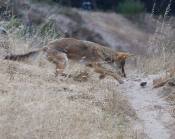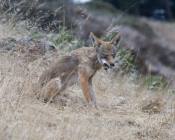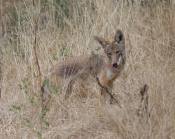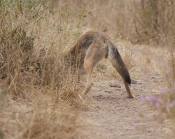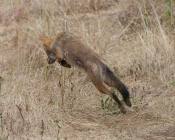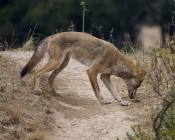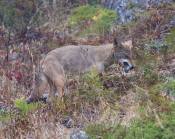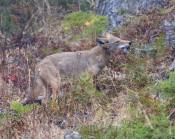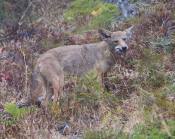In the Bay Area, the unusual weather pattern has produced a bumper crop of voles. I saw this coyote pick up three voles in a row — by the time one was chewed and had gone down the hatch, the coyote had only to look down at the ground to grab its next one: it was like picking fruit off of a tree. The chewing process involves a point at which the coyote needs to a crush hard — the effort often causes them the squnch up their faces and close their eyes.
As we have found out, and are now being taught, it is always a good idea to attempt to fight your attacker off: this has proven to be very effective for humans who have been ambushed by mountain lions. Well, today I saw a little vole take the one-second chance he was given, to flip out of the coyote’s toothsome grasp. The lucky vole fell right next to a burrow opening, and down it scurried, deeply, not to be found again by this coyote: notice the coyote is sticking its nose as far down as possible into the vole’s burrow in the 6th photo.
This year there appears to be a huge bumper-crop of voles. I have never seen so many voles darting across the pathways in front of me as I walked in a park: I have seen 3-6 at once scurrying around within a blink of the eye. I watched a vole sit only 5 feet from me, either totally unconcerned or oblivious. When I got to within 2 feet of it, I wondered if blindness could be involved — but just then the vole scurried down a vole hole. We have not seen this type of vole behavior before. The rain pattern is quite different each year in this area. This year we had regular rain consistently for several months, whereas more typical would have been extreme rains with dry spells in-between. The regular rains this year helped plants proliferate which might not have otherwise. With the abundance of plants, the voles went to work reproducing: the signals from nature were that it would be one of plant abundance. But the rains stopped, and most of the foliage dried up, leaving a plethora of voles with a minimal amount of food to live on. So instead of remaining hidden in their burrows or in tall grasses, they have come out to the open to search for what they can. It is these voles that are feeding our coyotes so well.

